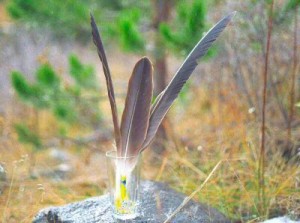Cultural misappropriation of sacred ceremony
Cultural misappropriation is a danger in adopting  traditional ceremonies for contemporary use. It is true that peoples on every continent have used solo time in nature for spiritual purposes. It is a human birthright—a way of connecting directly to the natural world and to deeper realms of spiritual realities. Yet so much has been taken from the first peoples of North America, and there have been incidents of anger about Caucasian groups using first peoples customs. Even in cases where a white person has been trained and given permission by a Native American medicine man, such as in the case of author and medicine woman Evelyn Eaton, others in Native American communities have disagreed and been angry with those who allow white participation in their traditional Native American ceremonies such as the pipe ceremony and sweat lodge.
traditional ceremonies for contemporary use. It is true that peoples on every continent have used solo time in nature for spiritual purposes. It is a human birthright—a way of connecting directly to the natural world and to deeper realms of spiritual realities. Yet so much has been taken from the first peoples of North America, and there have been incidents of anger about Caucasian groups using first peoples customs. Even in cases where a white person has been trained and given permission by a Native American medicine man, such as in the case of author and medicine woman Evelyn Eaton, others in Native American communities have disagreed and been angry with those who allow white participation in their traditional Native American ceremonies such as the pipe ceremony and sweat lodge.
What to do? How to navigate this territory of cultural misappropriation? Certainly, when using or adapting traditional first people ways, it is vitally important to do so with respect and with honouring of the first peoples of the land where we do sacred ceremony, and with thanks for the teachings we have received. The School of Lost Borders, which teaches a modern vision fast rite of passage, changed from using the term vision quest to using the term vision fast. They did this out of consideration for Native Americans.
I believe that in this time of ecological crisis the earth and all the people on it need us to be aware of our interconnectedness with the earth and all living creatures. The old ways of the first peoples are needed, to help foster this awareness. Some Native American leaders and writers agree that the old ways are needed, and they are willing to teach them to all people, regardless of race. With over 50% of the earth’s population living in cities now, we need a ceremony that brings people out into wild nature. And certainly, people of all ages need rites of passage to bring meaning, celebration, and an awareness of being part of the wholeness of our world. I believe that the need for and value of this ceremony is great. My own personal experience of it, fasting annually for the past three years, is that it is so healing and transformative that I want to offer this experience to others. So I have chosen to learn to guide others in the vision fast ceremony as taught by the School of Lost Borders.
 My friend Janet, who has the Métis heritage, gave me an eagle feather and sage to use for smudging in the traditional way. I feel she invited me into these ways with her gifts. She has encouraged me to offer the teachings I learn to First Nations people in the Merritt area. I have felt shy about doing this, and think it must be very inappropriate. But she told me to do it. People want to be in the sacred ceremony. In some cases the old ways have been lost to the first peoples themselves, and they are hungry to learn wherever they can. I have invited First Nations people from the Merritt area to events at Monkey Valley, and will continue to do so, even though I still feel very shy about it.
My friend Janet, who has the Métis heritage, gave me an eagle feather and sage to use for smudging in the traditional way. I feel she invited me into these ways with her gifts. She has encouraged me to offer the teachings I learn to First Nations people in the Merritt area. I have felt shy about doing this, and think it must be very inappropriate. But she told me to do it. People want to be in the sacred ceremony. In some cases the old ways have been lost to the first peoples themselves, and they are hungry to learn wherever they can. I have invited First Nations people from the Merritt area to events at Monkey Valley, and will continue to do so, even though I still feel very shy about it.
I try to remember to use the sacred ceremonies I have learned with respect for the first peoples. I thank the ancestors of the land where the ceremony is being held. I thank the spirits of the land, and the grandmothers and grandfathers, and ask for their help and guidance in keeping the fasters safe and teaching them what they need to know. The spirits seem to listen and to help. This is all I know.

